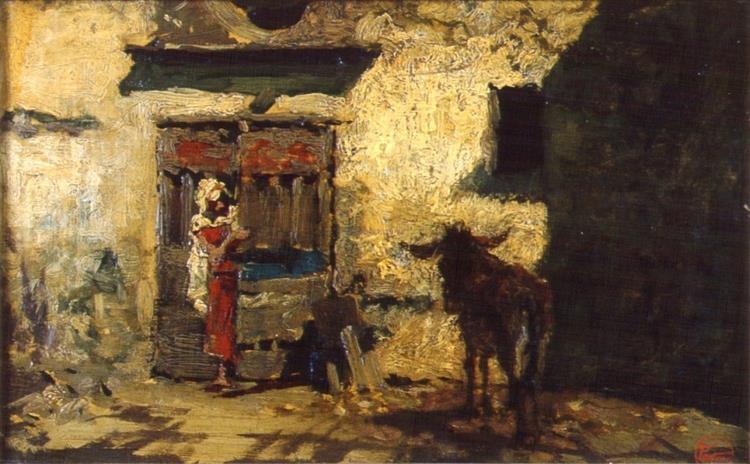Description
The work "Arab husband", by the Spanish painter Mariano Fortuny, represents one of the most fascinating manifestations of his art, deeply integrated into the context of orientalism, an artistic movement that sought to capture the essence of the cultures of the Middle East and the Maghreb. Painted in 1872, this work reveals both Fortuny's technical mastery and its ability to evoke the atmosphere and feeling of a world away from its own Spanish reality.
The "Arab husband" composition is intriguing and carefully constructed. At first glance, the look is trapped by the central figure, a man dressed in traditional Arab clothes that emanates dignity and serenity. The way Fortuny has portrayed the character, using a frame that highlights his worthy position, invites us to reflect on the identity and social role he performs. The figure, located in a richly decorated architectural context, suggests an intimate space but also of cultural relevance, which enhances the richness of the environment. The use of arches and decorative elements in the background is structured so that it not only serves as a backdrop, but also creates a visual dialogue with the main character.
The color in this work is another characteristic that deserves a special mention. Fortuny uses a subtle but vibrant palette, where earthly tones, such as ocher and brown, combine with more saturated nuances of red and green. These colors are not simply decorative; On the contrary, they seem to tell a story about the climate, geography and culture of the place that tries to evoke. The light, which disperses gently over the figure, accentuates the textures of the fabrics and reveals the technical virtuosity of Fortuny in the representation of the surface and the movement.
As for the character's expression, it is worthy of analysis. His look, enigmatic and serene, invites contemplation. Fortuny manages to capture a psychological depth that transcends mere physical representation. This ability to infuse character and emotion in his figures is one of the reasons why Fortuny is highly recognized in the field of art. However, painting is not limited to a mere portrait, but can also be interpreted as a reflection on everyday life, customs and cultural identity of a world that fascinated many Western artists of the time.
At the historical level, the work is a reflection of Fortuny's interest in the Arab world, an issue that explored in several of his works. His trip to Morocco, where he studied local art and life, significantly influenced his style and artistic vision. This is reflected in "Arab husband", which, although it creates a stereotype comprised by the western gaze, is also an affirmation of Fortuny's genuine interest towards the cultures he portrayed.
In sum, "Arab husband" is not only offered as a work of art, but as a prism through which we can examine the intersection of orientalism with the Spanish culture of the nineteenth century. Mariano Fortuny invites us, through his master technique and his cultural vision, to explore the complexity of the human being in a specific context and, at the same time, universal. This painting, therefore, becomes a testimony of an era where curiosity and fascination with the exotic aroused not only interest, but also an eager to understand and connect different worlds. Thus, Fortuny stands not only as an artist of his time, but as a bridge between cultures, through his gaze and sensitivity.
KUADROS ©, a famous paint on your wall.
Hand-made oil painting reproductions, with the quality of professional artists and the distinctive seal of KUADROS ©.
Art reproduction service with satisfaction guarantee. If you are not completely satisfied with the replica of your painting, we refund your money 100%.

